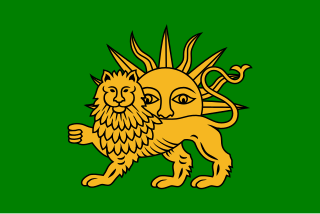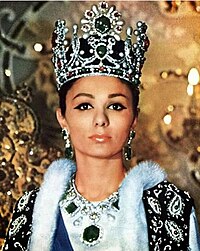
Hormizd-Ardashir, better known by his dynastic name of Hormizd I, was the third Sasanian King of Kings (shahanshah) of Iran, who ruled from May 270 to June 271. He was the third-born son of Shapur I, under whom he was governor-king of Armenia, and also took part in his father's wars against the Roman Empire. Hormizd I's brief time as ruler of Iran was largely uneventful. He built the city of Hormizd-Ardashir, which remains a major city today in Iran. He promoted the Zoroastrian priest Kartir to the rank of chief priest (mowbed) and gave the Manichaean prophet Mani permission to continue his preaching.

Hormizd II was king (shah) of the Sasanian Empire. He ruled for six years and five months, from 303 to 309. He was a son and successor of Narseh.

Shapur I was the second Sasanian King of Kings of Iran. The precise dating of his reign is disputed, but it is generally agreed that he ruled from 240 to 270, with his father Ardashir I as co-regent until the death of the latter in 242. During his co-regency, he helped his father with the conquest and destruction of the city of Hatra, whose fall was facilitated, according to Islamic tradition, by the actions of his future wife al-Nadirah. Shapur also consolidated and expanded the empire of Ardashir I, waged war against the Roman Empire, and seized its cities of Nisibis and Carrhae while he was advancing as far as Roman Syria. Although he was defeated at the Battle of Resaena in 243 by Roman emperor Gordian III, he was the following year able to win the Battle of Misiche and force the new Roman emperor Philip the Arab to sign a favorable peace treaty that was regarded by the Romans as "a most shameful treaty".

The Safavid dynasty was one of Iran's most significant ruling dynasties reigning from 1501 to 1736. Their rule is often considered the beginning of modern Iranian history, as well as one of the gunpowder empires. The Safavid Shāh Ismā'īl I established the Twelver denomination of Shīʿa Islam as the official religion of the Persian Empire, marking one of the most important turning points in the history of Islam. The Safavid dynasty had its origin in the Safavid order of Sufism, which was established in the city of Ardabil in the Iranian Azerbaijan region. It was an Iranian dynasty of Kurdish origin, but during their rule they intermarried with Turkoman, Georgian, Circassian, and Pontic Greek dignitaries, nevertheless they were Turkic-speaking and Turkified. From their base in Ardabil, the Safavids established control over parts of Greater Iran and reasserted the Iranian identity of the region, thus becoming the first native dynasty since the Sasanian Empire to establish a national state officially known as Iran.

The Qajar dynasty was an Iranian dynasty founded by Mohammad Khan of the Qoyunlu clan of the Turkoman Qajar tribe.

Safi-ad-Din Ardabili was a Kurdish poet, mystic, teacher and Sufi master. He was the son-in-law and spiritual heir of the Sufi master Zahed Gilani, whose order—the Zahediyeh—he reformed and renamed the Safaviyya, which he led from 1301 to 1334.

Azarmidokht was Sasanian queen (banbishn) of Iran from 630 to 631. She was the daughter of king (shah) Khosrow II. She was the second Sasanian queen; her sister Boran ruled before and after her. Azarmidokht came to power in Iran after her cousin Shapur-i Shahrvaraz was deposed by the Parsig faction, led by Piruz Khosrow, who helped Azarmidokht ascend the throne. Her rule was marked by an attempt of a nobleman and commander Farrukh Hormizd to marry her and come to power. After the queen's refusal, he declared himself an anti-king. Azarmidokht had him killed as a result of a successful plot. She was, however, killed herself shortly afterwards by Rostam Farrokhzad in retaliation for his father's death. She was succeeded by Boran.
The page details the timeline of History of Iran.
Abu Ali Muhammad Bal'ami, also called Amirak Bal'ami and Bal'ami-i Kuchak, was a 10th-century Persian historian, writer, and vizier to the Samanids. He was from the influential Bal'ami family.

The Ottoman–Persian War of 1775–1776 was fought between the Ottoman Empire and the Zand dynasty of Persia. The Persians, ruled by Karim Khan and led by his brother Sadeq Khan Zand, invaded southern Iraq and after besieging Basra for a year, took the city from the Ottomans in 1776. The Ottomans, unable to send troops, were dependent on the Mamluk governors to defend that region.

The Kar-Kiya dynasty, also known as the Kiya'ids, was a local Zaydi dynasty which mainly ruled over Biya-pish from the 1370s to 1592.

Farrukh Hormizd or Farrokh Hormizd, also known as Hormizd V, was an Iranian prince, who was one of the leading figures in Sasanian Iran in the early 7th-century. He served as the military commander (spahbed) of northern Iran. He later came in conflict with the Iranian nobility, "dividing the resources of the country". He was later killed by Siyavakhsh in a palace plot on the orders of Azarmidokht after he proposed to her in an attempt to usurp the Sasanian throne. He had two children, Rostam Farrokhzad and Farrukhzad.
Allahverdi Khan was a Safavid military officer of Armenian origin. He was the son of a certain Khosrow Khan, and had a brother named Emamverdi Beg.
Salman Khan Ustajlu was a Turkoman military leader from the Ustajlu tribe, who became a powerful and rich figure during his service in Safavid Iran. He briefly served as the grand vizier of the Safavid king (shah) Abbas I from 1621 until his death in 1623/4. He was succeeded by Khalifeh Sultan.

Pars was a Sasanian province in Late Antiquity, which almost corresponded to the present-day province of Fars. The province bordered Khuzestan in the west, Kirman in the east, Spahan in the north, and Mazun in the south.

Kirman was a Sasanian province in Late Antiquity, which almost corresponded to the present-day province of Kerman. The province bordered Pars in the west, Abarshahr and Sakastan in the northeast, Paradan in the east, Spahan in the north, and Mazun in the south. The capital of the province was Shiragan.
The Khalifeh family, also known as the Khalifeh sayyids, were a branch of the Marashi dynasty of Mazandaran, whose ancestor, Amir Nezam al-Din, had settled in the Golbar quarter of Isfahan in the 15th century.
Mirza Mohammad Mahdi Karaki was an Iranian cleric and statesman, who served as the grand Vizier of the Safavid king (shah) Abbas II, and the latter's son and successor Suleiman I. He was the son of Mirza Habibollah Karaki, who served as the sadr-i mamalik from 1632/3 till his death 1650.


































